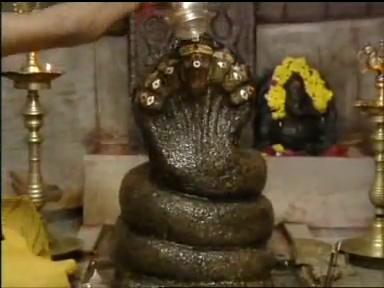Virabhadrasana (gracious warrior pose) |  |
 | |  |
 | Vira - Warrior; Bhadra - Gracious
In this asana, the body looks like that of a warrior extending his hands out to help another, hence the name Gracious Warrior pose?
|  |
 | Taking the asana position
| 1. | Step the left leg forward as far away from the right leg as is comfortable. |
| 2. | Bend the left knee at a 90 degree angle and place the hands on the knee, palms joined together. |
| 3. | Exhale and while inhaling raise the joined hands forward until the arms are parallel to the ground. |
| 4. | Exhale, bend the body forward about 45 degrees, so that the right leg, the trunk of the body and the head forms a diagonal line. Continue to maintain the asana, breathing normally. |
|
|  |
 | The asana positionIn this position there should be enough distance between the legs. Ideally the front leg should be bent at a 90 degree angle. The back leg should remain straight. The back leg, trunk of the body, neck and head should form a diagonal straight line. The arms are straight and parallel to the ground, and the eyes are gazing forward.
|  |
 | Releasing the asana position
| 1. | Exhale and inhaling, slowly straighten the body. |
| 2. | Exhale and place the hands back on the knees. |
| 3. | Straighten the knee and release the hands. |
| 4. | Restore the left leg to its place and return to standing position. |
Practice on the other side.
|  |
 | Anatomical focus |  |
 | Awareness |  |
 | Do's
| 1. | Place the right foot at a 45 degree angle to the left foot. (The angle may vary as per the convenience of every individual.) |
|
| 2. | Keep the hips and torso facing the front. |
| 3. | Bend the left leg to a 90 degree angle so the thigh is parallel with the floor. |
| 4. | Keep the arms straight and parallel to the ground. |
| 5. | Pull the shoulders back, opening the chest. |
| 6. | Keep both the heels on the ground. |
|  |
 | Dont's
| 1. | Bend the arms or the right leg. |
| 2. | Overextend the left knee such that it goes over the left toes. |
|  |
 | Benefits
| 1. | Improves the strength and blood supply to the joints like the ankles, knees, hips, lumber region, cervical region and shoulders. |
|
| 2. | Improves the flexibility of the spinal column. |
| 3. | Puts pressure on the digestive organs and increases their efficiency and function. |
| 4. | Strengthens the legs. |
| 5. | Puts pressure on the nervous system and improves coordination of the nervous system with the musculoskeletal system. |
|
| 6. | Improves balance. |
| 7. | Reduces fat around the pelvic region. |
|  |
 | Therapeutic application |  |
 | Precautions & contra-indications |  |
 | Duration |  |
 | Variations & tipsIdeally the trunk of the body should be away from the thigh of the left leg and should form a straight diagonal line with the back leg. However, if the back is not strong enough to support the upper body in the initial stages of practice, it is ok to rest the upper body on the thigh of the front leg.
The front leg should also be bent at 90 degrees, but if the leg is not strong enough initially, it is ok to have the leg bent at more than 90 degrees, as long as the knee is not extending over the toes.
|  |
 | Preparatory poses |  |
 | Follow-up poses |  |
 | Ancient texts |  |
 | |


కామెంట్లు లేవు:
కామెంట్ను పోస్ట్ చేయండి